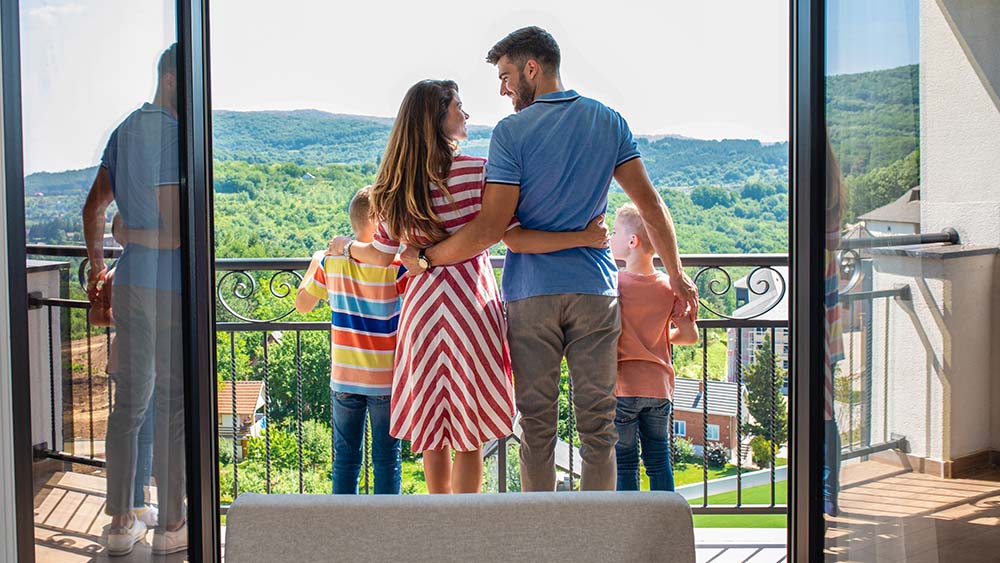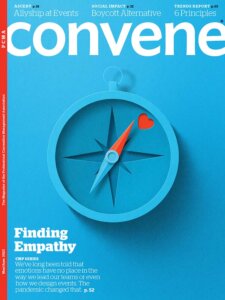
One way to plan an event with empathy is to consider meeting in a vibrant destination where attendees could bring their families and stay for a vacation after the event.
If you missed the first two parts of our interview with future of work experts and The Empathy Advantage: Leading the Empowered Workforce authors Heather E. McGowan and Chris Shipley, you can catch up here:
- Part 1: ‘It’s About Having Empathy All the Way Around’
- Part 2: ‘Does Leading With Empathy Mean You’re a Pushover?’
Let’s pick up where we left off, just as they address the challenge of bringing workers back to physical offices and how that crosses over into the business of events.

This interview is part of our May/June cover and CMP Series story package. Find the print facsimile edition here.
One of the struggles employers have is bringing people back to the office.
McGowan: Part of that is if you do get together in person — like I spoke virtually for two years, now I speak almost all the time in person, but there’s a reason for me to go get in front of people — there has to be a good reason to go to the office and meet with people. What you’re doing [by forcing people to work in an office] is we’re eroding our working moms, our diverse candidates in every way. If you’ve got a physical disability that makes it harder for you to commute, you’ve just added another hurdle. If you’re neurodiverse and being in the office makes you more stressed out, you just added another hurdle. If you’re a working mom or dad and you can’t get childcare, you just added another hurdle.
To get together in person should happen when we have a reason to do so and you need concrete evidence. Not because bosses want to breathe on their people and feel like they’re working — all this really fundamental erosion of trust.
I think the corollary to that for the events industry is it used to be assumed that everybody was going to travel to a conference to be face to face. Now people’s calculus has changed. How can events be designed from a more empathetic perspective?
McGowan: I’d lean into the bleisure play. You’ve got an event, it’s in a fun city people want to go to. Think about all the fun things people could do when they’re there. Can they bring their family members? Can they connect with people?
It reminds me of a conversation that Chris and I had in one of her interviews for the book with Mercy Health when they were designing their new office campus. Rather than saying, “Oh, it’s going to be open [concept] or private offices, wherever,” they said: “What are all the things that somebody needs to do when they leave the house and how can we be an answer to more of those things? Oil changes, dry cleaning, grocery shopping, how can we create a campus that allows you to one-stop shop?”
You’re coming in for a three-hour meeting, get your oil changed while you’re there, pick up your dry cleaning, pick up some groceries on the way out. Think about an event in that same way. You’re going to have a reunion with some folks. You’re going to have an experience. You’re going to have networking; hopefully, have great content. You’re in a fun city, you’ve got other events going on. Think about the whole picture of what people want to experience.
Shipley: The onus is on event planners, on business leaders, to really curate an experience, whether that’s by placing an event in a lovely place so that the whole family can have a bit of vacation as part of it, as Heather was suggesting with the bleisure travel movement. Also, a conference now needs to be more than sitting in a dark room look- ing at a stage. As fantastic as many speakers are — Heather included — that’s not enough.
I was at one of the first events of a community last year and there was an amazing keynote speaker speaking over lunch. The 2,000 people in that room forgot their manners because these rounds of 10 people were talking so much with each other that they were drowning out the speaker. People who actually wanted to hear the talk couldn’t. It was frustrating for the speaker.

Heather E. McGowan (left) and Chris Shipley
But something else was happening in that room. They were there for some reason other than sitting and listening to a keynote. I think that for me was the takeaway — the behavior is different, there’s a bit of reunion behavior, there’s a bit of collaboration behavior, there’s a learning from one another behavior, that has to be more than just, “Here’s this list of amazing speakers, come hear them.” We learned that we can sit in our homes comfortably in our sweats and listen to great speakers. What is it that gets people to come to an event? It’s going to be a lot more than trying to sell a speaker agenda.
Again, it goes back to the point that Heather was making about why we are bringing people together [in the workplace]. If it’s because I’m the boss and if I don’t see you, I don’t believe you’re working, you need to look inside yourself and have a really serious conversation with yourself as a leader to ask why you’ve lost trust in your team.
Because that’s what is happening in that moment — I don’t trust these people if I don’t see them. I don’t buy for a minute, the BS of the creative collaborations and collisions that happen when we get together for coffee. I think that does happen sometimes, but it happens in an environment where that is intentional. If your creative illusions require people to accidentally meet one another over a pot of coffee, you’ve got another problem with your business.
The return to office [argument] — that we had these amazing collaborations and accidental discoveries and wonderful creativity when we were all in the room together — misunderstands what being in the room together really does. When you bring people together to say, “We are here because we’ve got this challenge [and we need] to work on it, we have this opportunity to address some new line of business we’ve got to design together. Let’s get everyone on the same page, have our pre- work, so we come prepared and then do that work together.” Those creative collaborations now have a context.
For a leader, it used to be this: “There’s going to be a staff meeting at 10 on Tuesday — be there,” and nobody prepared for that. They just showed up and waited for somebody to talk. Now we’re asking a lot more of everyone but of the leader to explain why we’re here and what our intent is. One of the people we spoke with [for the book] said, “Forget having meetings — have reviews. People don’t prepare for meetings but they prepare for a review.” If you’re going to review something, people will come in ready to have a productive conversation.
Michelle Russell is editor in chief of Convene.
